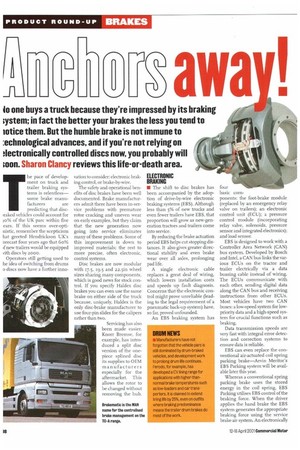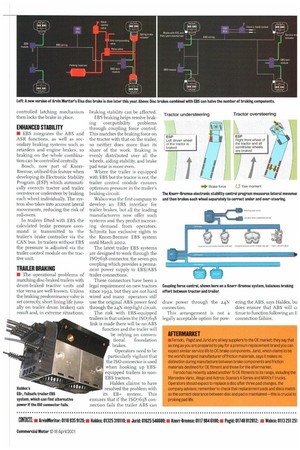io one buys a truck because they're impressed by its
Page 40

Page 41

If you've noticed an error in this article please click here to report it so we can fix it.
braking ;ystem; in fact the better your brakes the less you tend to mtice them. But the humble brake is not immune to :echnological advances, and if you're not relying on electronically controlled discs now, you probably will mon. Sharon Clancy reviews this life-or-death area.
The pace of development on truck and trailer braking systems is relentless— some brake manu facturers are predicting that disc'raked vehicles could account for yo% of the UK parc within five ears. If this seems over-optinistic, remember the scepticism hat greeted Hendrickson UK's orecast four years ago that 6o% if new trailers would be equipped vith discs by z000.
Operators still getting used to he idea of switching from drums o discs now have a further inno
vation to consider: electronic braking control, or brake-by-wire.
The safety and operational benefits of disc brakes have been well documented. Brake manufacturers admit there have been in-service problems with premature rotor cracking and uneven wear on early examples, but they claim that the new generation now going into service eliminates many of these problems. Some of this improvement is down to improved materials; the rest to more precise, often electronic, control systems.
Disc brakes are now modular with 17.5, 19.5 and 22.5in wheel sizes sharing many components, which is good news for stock control. If you specify Haldex disc brakes you can even use the same brake on either side of the truck because, uniquely, Haldex is the only disc-brake manufacturer to use four-pin slides for the calipers rather than two.
Servicing has also been made easier. Knorr Bremse, for example, has introduced a split disc version of the onepiece splined disc its supplies to OEM manufacturers especially for the aftermarket. This allows the rotor to be changed without removing the hub. ELECTRONIC BRAKING • The shift to disc brakes has been accompanied by the adoption of drive-by-wire electronic braking systems (EBS). Although less than 5% of new trucks and even fewer trailers have EBS, that proportion will grow as new-generation tractors and trailers come into service.
By reducing the brake actuation period EBS helps cut stopping distances. It also gives greater directional stability and even brake wear over all axles, prolonging pad life.
A single electronic cable replaces a great deal of wiring, which lowers installation costs and speeds up fault diagnosis. Concerns that the electronic control might prove unreliable (leading to the legal requirement of a pneumatic back-up system) have, so far, proved unfounded.
An EBS braking system has four basic com ponents: the foot-brake module (replaced by an emergency relay valve on trailers); an electronic control unit (ECU); a pressure control module (incorporating relay valve, solenoids, pressure sensor and integrated electronics); and load sensor.
EBS is designed to work with a Controller Area Network (CAN) bus system. Developed by Bosch and Intel, a CAN bus links the various ECUs on the tractor and trailer electrically via a data bussing cable instead of wiring. The ECUs communicate with each other, sending digital data along the CAN bus and receiving instructions from other ECUs. Most vehicles have two CAN buses: a low-speed system for lowpriority data and a high-speed system for crucial functions such as braking.
Data transmission speeds are very fast with integral error detection and correction systems to ensure data is reliable.
EBS can even replace the conventional air-actuated coil spring parking brake—Arvin Mentor's EBS Parking system will be available later this year.
Whereas a conventional spring parking brake uses the stored energy in the coil spring, EBS Parking utilises EBS control of the braking force. When the driver applies the hand brake the EBS system generates the appropriate braking force using the service brake air system. An electronically controlled latching mechanism then locks the brake in place.
ENHANCED STABILITY • EBS integrates the ABS and ASR functions, as well as secondary braking systems such as retarders and engine brakes, so braking on the whole combination can be controlled centrally.
Bosch, now part of KnorrBremse, utilised this feature when developing its Electronic Stability Program (ESP) which automatically corrects tractor and trailer oversteer or understeer by braking each wheel individually. The system also takes into account lateral movements, reducing the risk of roll-overs.
In trailers fitted with EBS the calculated brake pressure command is transmitted to the trailer's brake controller via the CAN bus. In trailers without EBS the pressure is adjusted via the trailer control module on the tractive unit.
TRAILER BRAKING • The operational problems of matching disc-braked trailers with dram-braked tractive units and vice versa are well known. Unless the braking predominance valve is set correctly, short lining life (usually on trailer drum brakes) can result and, in extreme situations, braking stability can be affected. EBS braking helps resolve braking compatibility problems through coupling force control. This matches the braking force on the tractor with that on the trailer, so neither does more than its share of the work. Braking is evenly distributed over all the wheels, aiding stability, and brake pad wear is more even.
Where the trailer is equipped with EBS but the tractor is not, the trailer control module ensures optimum pressure in the trailer's braking circuit.
Wabco was the first company to develop an EBS interface for trailer brakes, but all the leading manufacturers now offer such systems and they predict increasing demand from operators. Schmitz has exclusive rights to the Knorr-Bremse EBS system until March 2002.
The latest trailer EBS systems are designed to work through the 1S07638 connector, the seven-pin coupling which provides a permanent power supply to EBS/ABS trailer connections.
These connectors have been a legal requirement on new tractors since 5992, but they are not hard wired and many operators still use the original ABS power feed through the 24N stop-light circuit. The risk with EBS-equipped trailers is that unless the 1507638 link is made there will be no ABS function and the trailer will be relying on conven tional foundation brakes.
Operators need to be particularly vigilant that the ISO connector is used when hooking up EBSequipped trailers to nonEBS tractors.
Haldex claims to have resolved the problem with its EB+ system. This ensures that if the 1S07638 connection fails the trailer ABS can
































































































